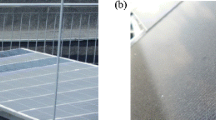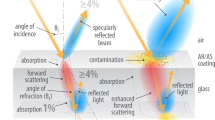Abstract
The photovoltaic modules are mostly installed outdoors, exposing them to different conditions. These conditions significantly affect their performance. One of the most influential factors on photovoltaic modules is the soiling phenomenon from dust deposition. Dust deposition on the surface of the modules causes transmittance loss. Some studies in different parts of the world have tried to find mathematical correlations between particulate deposition and transmittance. These correlations are a function of dust characteristics and environmental factors. This study proposes a new methodology to mathematically combine the photovoltaic model and transmittance loss correlations. The proposed model could examine and predict the effect of soiling on photovoltaic modules’ performance. Three photovoltaic modules with different capacities are selected. Using the proposed model, they are modeled by assuming clean and dirty photovoltaic surfaces depending on the installation conditions. This study is based on actual data from the center of Tehran, located at 35° 41′ north latitude and 51° 23′ east longitude for 12 months in the year 2020. The module’s performance was investigated in the presence of dust. The presented results are validated by comparing them with other studies. The results show that the soiling effect is not dependent on the modules’ capacity.









Similar content being viewed by others
References
Abdolzadeh M, Nikkhah R (2019) Experimental study of dust deposition settled over tilted PV modules fixed in different directions in the southeast of Iran. Environ Sci Pollut Res 26(30):31478–31490. https://doi.org/10.1007/s11356-019-06246-z; http://springer.longhoe.net/10.1007/s11356-019-06246-z
Al-Addous M, Dalala Z, Alawneh F, Class CB (2019) Modeling and quantifying dust accumulation impact on PV module performance. Sol Energy 194:86–102. https://doi.org/10.1016/j.solener.2019.09.086; https://linkinghub.elsevier.com/retrieve/pii/S0038092X19309612
Boyle L, Flinchpaugh H, Hannigan MP (2015) Natural soiling of photovoltaic cover plates and the impact on transmission. Renew Energy 77:166–173. https://doi.org/10.1016/j.renene.2014.12.006; https://linkinghub.elsevier.com/retrieve/pii/S0960148114008325
Boyle L, Flinchpaugh H, Hannigan M (2016) Assessment of PM dry deposition on solar energy harvesting systems: measurement–model comparison. Aerosol Sci Technol 50(4):380–391. https://doi.org/10.1080/02786826.2016.1153797; https://www.tandfonline.com/doi/pdf/10.1080/02786826.2016.1153797?needAccess=true
Chen J, Pan G, Ouyang J, Ma J, Lei F, Zhang L (2020) Study on impacts of dust accumulation and rainfall on PV power reduction in East China. Energy 194:116915. https://doi.org/10.1016/j.energy.2020.116915https://www.sciencedirect.com/science/article/pii/S0360544220300220
Conceição R, Silva HG, Fialho L, Lopes FM, Collares-Pereira M (2019) PV system design with the effect of soiling on the optimum tilt angle. Renew Energy 133:787–796. https://doi.org/10.1016/j.renene.2018.10.080; https://linkinghub.elsevier.com/retrieve/pii/S0960148118312722
Duffie JA, Beckman WA, Blair N (2020) Solar engineering of thermal processes, photovoltaics and wind, 5th edn. Wiley, Hoboken
El-Shobokshy MS, Hussein FM (1993) Degradation of photovoltaic cell performance due to dust deposition on to its surface. Renew Energy 3(6):585–590. https://doi.org/10.1016/0960-1481(93)90064-N; https://www.sciencedirect.com/science/article/pii/096014819390064N
Elminir HK, Ghitas AE, Hamid RH, El-Hussainy F, Beheary MM, Abdel-Moneim KM (2006) Effect of dust on the transparent cover of solar collectors. Energy Convers Manag 47(18-19):3192–3203. https://doi.org/10.1016/j.enconman.2006.02.014; https://linkinghub.elsevier.com/retrieve/pii/S0196890406000562
Fan S, Wang Y, Cao S, Sun T, Liu P (2021) A novel method for analyzing the effect of dust accumulation on energy efficiency loss in photovoltaic (PV) system. Energy 234:121112. https://doi.org/10.1016/j.energy.2021.121112https://www.sciencedirect.com/science/article/pii/S0360544221013608
Gholami A, Khazaee I, Eslami S, Zandi M, Akrami E (2018) Experimental investigation of dust deposition effects on photo-voltaic output performance. Sol Energy 159:346–352. https://doi.org/10.1016/j.solener.2017.11.010; https://linkinghub.elsevier.com/retrieve/pii/S0038092X17309908
Gholami A, Saboonchi A, Alemrajabi AA (2017) Experimental study of factors affecting dust accumulation and their effects on the transmission coefficient of glass for solar applications. Renew Energy 112:466–473. https://doi.org/10.1016/j.renene.2017.05.050; https://linkinghub.elsevier.com/retrieve/pii/S0960148117304354
Gueymard CA (2017) Cloud and albedo enhancement impacts on solar irradiance using high-frequency measurements from thermopile and photodiode radiometers. Part 2: performance of separation and transposition models for global tilted irradiance. Sol Energy 153:766–779. https://doi.org/10.1016/j.solener.2017.04.068; https://www.sciencedirect.com/science/article/pii/S0038092X17303730
Haddad AG, Dhaouadi R (2018) Modeling and analysis of PV soiling and its effect on the transmittance of solar radiation. In: 2018 Advances in Science and Engineering Technology International Conferences (ASET). IEEE, Abu Dhabi, pp 1–5. https://doi.org/10.1109/ICASET.2018.8376787
Hegazy AA (2001) Effect of dust accumulation on solar transmittance through glass covers of plate-type collectors. Renew Energy 22(4):525–540. https://doi.org/10.1016/S0960-1481(00)00093-8; https://linkinghub.elsevier.com/retrieve/pii/S0960148100000938
Huang P, Guoqiang H, Zhao X, Luyi L, Ding H, Li J (2022) Effect of organics on the adhesion of dust to PV panel surfaces under condensation. Energy 261:125255. https://doi.org/10.1016/j.energy.2022.125255; https://www.sciencedirect.com/science/article/pii/S0360544222021417
Ilse KK, Rabanal J, Schönleber L, Khan MZ, Naumann V, Hagendorf C, Bagdahn J (2018a) Comparing indoor and outdoor soiling experiments for different glass coatings and microstructural analysis of particle caking processes. IEEE Journal of Photovoltaics 8(1):203–209. https://doi.org/10.1109/JPHOTOV.2017.2775439
Ilse KK, Figgis BW, Werner M, Naumann V, Hagendorf C, Pöllmann H, Bagdahn J (2018b) Comprehensive analysis of soiling and cementation processes on PV modules in Qatar. Sol Energy Mater Sol Cells 186:309–323. https://doi.org/10.1016/j.solmat.2018.06.051; https://linkinghub.elsevier.com/retrieve/pii/S092702481830360X
Kumar M, Kumar A (2017) An efficient parameters extraction technique of photovoltaic models for performance assessment. Sol Energy 158:192–206. https://doi.org/10.1016/j.solener.2017.09.046; https://linkinghub.elsevier.com/retrieve/pii/S0038092X17308332
Laarabi B, Sankarkumar S, Rajasekar N, El Baqqal Y, Barhdadi A (2022) Modeling investigation of soiling effect on solar photovoltaic systems: new findings. Sustain Energy Technol Assess 52:102126. https://doi.org/10.1016/j.seta.2022.102126; https://www.sciencedirect.com/science/article/pii/S2213138822001783
Mastekbayeva GA, Kumar S (2000) Effect of dust on the transmittance of low density polyethylene glazing in a tropical climate. Sol Energy 68(2):7
Mustafa RJ, Gomaa MR, Al-Dhaifallah M, Rezk H (2020) Environmental impacts on the performance of solar photovoltaic systems. Sustainability 12(2):608 https://www.mdpi.com/2071-1050/12/2/608
Oh S (2019) Analytic and Monte-Carlo studies of the effect of dust accumulation on photovoltaics. Sol Energy 188:1243–1247. https://doi.org/10.1016/j.solener.2019.07.011; https://linkinghub.elsevier.com/retrieve/pii/S0038092X19306656
Ndeto P, Martin DW, Wekesa FN, Kinyua R (2022) Correlating dust deposits with wind speeds and relative humidity to overall performance of crystalline silicon solar cells: an experimental study of Machakos County, Kenya. Sol Energy 246:203–215. https://doi.org/10.1016/j.solener.2022.09.050; https://www.sciencedirect.com/science/article/pii/S0038092X22007277
Pulipaka S, Kumar R (2018) Analysis of soil distortion factor for photovoltaic modules using particle size composition. Sol Energy 161:90–99. https://doi.org/10.1016/j.solener.2017.11.041; https://linkinghub.elsevier.com/retrieve/pii/S0038092X17310241
Rodrigo PM, Gutiérrez S, Micheli L, Fernández EF, Almonacid FM (2020) Optimum cleaning schedule of photovoltaic systems based on levelised cost of energy and case study in central Mexico. Sol Energy 209:11–20. https://doi.org/10.1016/j.solener.2020.08.074; https://linkinghub.elsevier.com/retrieve/pii/S0038092X20309154
Said SAM, Hassan G, Walwil HM, Al-Aqeeli N (2018) The effect of environmental factors and dust accumulation on photovoltaic modules and dust-accumulation mitigation strategies. Renew Sust Energ Rev 82:743–760. https://doi.org/10.1016/j.rser.2017.09.042; https://linkinghub.elsevier.com/retrieve/pii/S1364032117312959
Salah WA, Abuhelwa M, Bashir MJK (2021) The key role of sustainable renewable energy technologies in facing shortage of energy supplies in Palestine: current practice and future potential. J Clean Prod 293:125348. https://doi.org/10.1016/j.jclepro.2020.125348; https://www.sciencedirect.com/science/article/pii/S0959652620353932
Salimi H, Ashtiani HAD, Lavasani AM, Fazaeli R (2020) Experimental analysis and modeling of weather condition effects on photovoltaic systems’ performance: Tehran case study. Energy Sources, Part A: Recovery, Utilization, and Environmental Effects 1-13. https://doi.org/10.1080/15567036.2020.1765902; https://www.tandfonline.com/doi/full/10.1080/15567036.2020.1765902
Sarver T, Al-Qaraghuli A, Kazmerski LL (2013) A comprehensive review of the impact of dust on the use of solar energy: history, investigations, results, literature, and mitigation approaches. Renew Sust Energ Rev 22:698–733. https://doi.org/10.1016/j.rser.2012.12.065; https://linkinghub.elsevier.com/retrieve/pii/S136403211300021X
Solcast (2020) Solar Api and solar weather forecasting tool. Solcast. Available: https://solcast.com/. Accessed 1 Feb 2021
Zhao W, Lv Y, Zhou Q, Yan W (2021) Investigation on particle deposition criterion and dust accumulation impact on solar PV module performance. Energy 233:121240. https://doi.org/10.1016/j.energy.2021.121240; https://www.sciencedirect.com/science/article/pii/S0360544221014882
Author information
Authors and Affiliations
Contributions
All authors contributed to the study conception and design. Material preparation, data collection, and analysis were performed by AH, MM, and RD. The first draft of the manuscript was written by AH and all authors commented on the manuscript. All authors read and approved the final manuscript. All authors have been personally and actively involved in substantial work leading to the paper and will take public responsibility for its content.
Corresponding author
Ethics declarations
Ethical approval
The results are appropriately placed in the context of prior and existing research.
Consent to participate
Informed consent was obtained from all individual participants included in the study.
Competing interests
The authors declare no competing interests.
Additional information
Communicated by: Philippe Garrigues
This material is the authors’ own original work, which has not been previously published elsewhere.
The paper is not currently being considered for publication elsewhere.
The paper reflects the authors’ own research and analysis in a truthful and complete manner.
Publisher’s note
Springer Nature remains neutral with regard to jurisdictional claims in published maps and institutional affiliations.
Rights and permissions
Springer Nature or its licensor (e.g. a society or other partner) holds exclusive rights to this article under a publishing agreement with the author(s) or other rightsholder(s); author self-archiving of the accepted manuscript version of this article is solely governed by the terms of such publishing agreement and applicable law.
About this article
Cite this article
Hosseini, ., Mirhosseini, M. & Dashti, R. Modeling of soiling losses on photovoltaic module based on transmittance loss effect. Environ Sci Pollut Res 30, 107733–107745 (2023). https://doi.org/10.1007/s11356-023-29901-y
Received:
Accepted:
Published:
Issue Date:
DOI: https://doi.org/10.1007/s11356-023-29901-y




